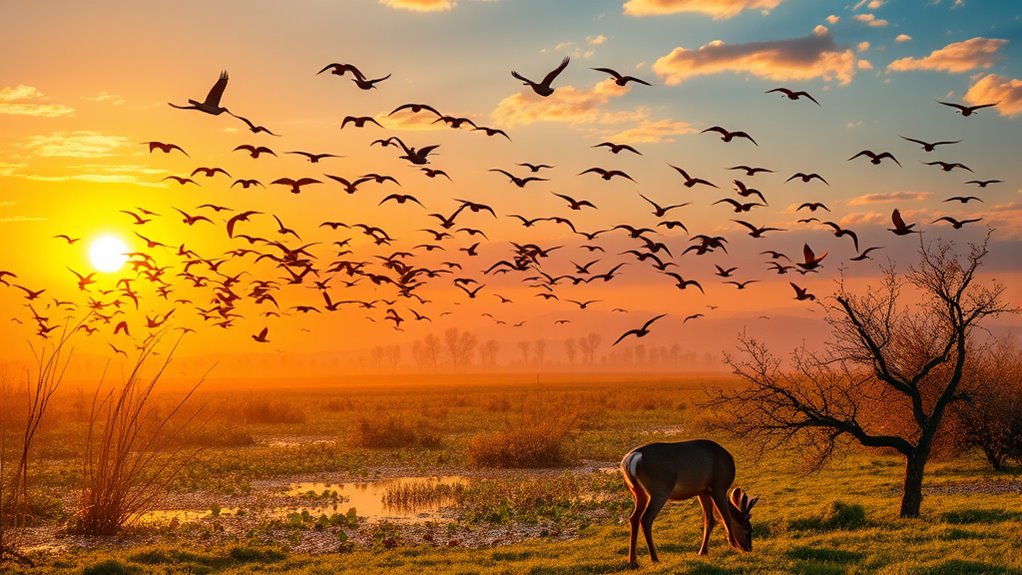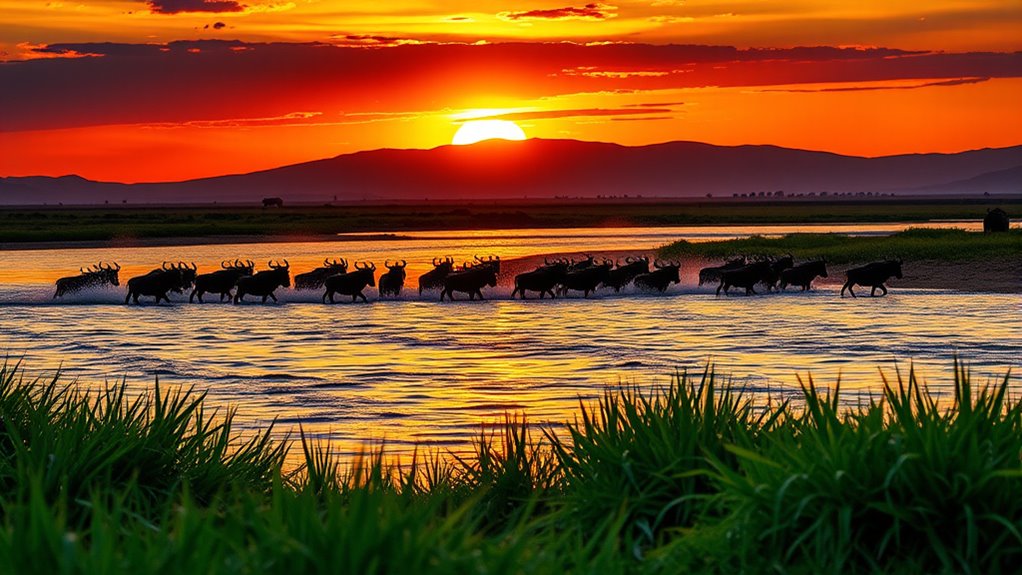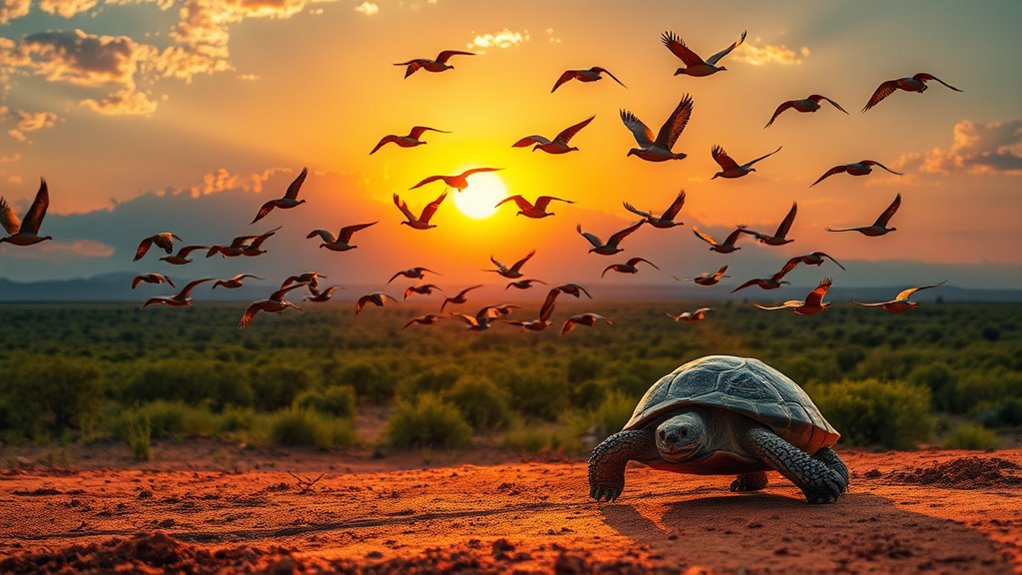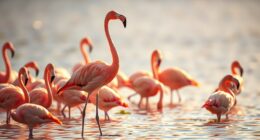Animal migration is crucial for maintaining ecological balance and supporting biodiversity. It helps in nutrient cycling, connects ecosystems, and enriches habitats. Economically, it fuels wildlife tourism, creating jobs and boosting local economies. However, migration faces threats like habitat destruction and climate change. Conservation efforts are essential to protect these routes and the species that rely on them. Discovering more about the intricacies of migration can deepen your understanding of its importance to our world.
Key Takeaways
- Animal migration is vital for maintaining ecological balance, facilitating nutrient cycling across ecosystems, and supporting biodiversity.
- Migratory species contribute significantly to local economies through wildlife tourism, creating jobs and enhancing community revenue.
- Hunting and fishing related to migratory species provide substantial economic benefits while supporting conservation efforts and habitat protection.
- Threats like habitat destruction and climate change compromise migration routes, jeopardizing the survival of numerous species.
- Cultural narratives surrounding migration foster respect for wildlife, inspire conservation actions, and promote community engagement in ecological preservation.
Ecological Role of Migration

Migration plays an essential role in maintaining ecological balance, as it connects various ecosystems and facilitates nutrient cycling. By migrating, species like salmon transport crucial nutrients, enriching freshwater and forest habitats with their carcasses.
Birds, on the other hand, aid nutrient cycling by dispersing seeds and nutrients over long distances. Large herbivores, such as wildebeest, contribute through their grazing patterns, ensuring nutrient distribution. Additionally, migratory species support biodiversity by allowing species to adapt to fluctuating resources, acting as keystone species that maintain ecological balance. The movement of these animals enhances genetic diversity and influences local species composition, creating a more interconnected environment.
Ultimately, migration strengthens ecological connectivity, linking isolated habitats and promoting overall ecosystem health.
Economic Impact of Migration

When you think about animal migration, consider how it boosts local economies through wildlife tourism. People flock to see migratory species, generating significant revenue and creating jobs in hunting and fishing industries. This economic impact not only supports communities but also highlights the importance of preserving these natural phenomena. Additionally, the long-distance migrators cover hundreds to thousands of kilometers annually, making their journeys a unique attraction for tourists.
Wildlife Tourism Revenue
Wildlife tourism generates substantial revenue, greatly impacting economies worldwide. In 2023, this sector generated an impressive $165.4 billion, supporting over 21.8 million jobs globally—comparable to the population of Sri Lanka.
Regions like Asia-Pacific lead the way, contributing $53.3 billion to GDP and employing 4.5 million people in 2018. Africa's wildlife tourism sector was worth $29.3 billion, while North America added $13.5 billion.
Growth continues, with Kenya and South Africa seeing a 25% revenue increase in 2023. This upward trend is projected to reach $286.9 billion by 2030, driven by a rising interest in sustainable travel. Furthermore, wildlife tourism not only boosts economies but also helps local communities thrive through essential employment opportunities.
Hunting and Fishing Benefits
Hunting and fishing play an essential role in the economy, especially through the lens of migratory species. By participating in these activities, you're not just enjoying nature; you're also contributing markedly to economic growth.
Here are some key benefits:
- Revenue Generation: Hunting generates $5.9 billion annually from migratory birds alone.
- Job Creation: Over 1.3 million jobs are supported by hunting activities.
- Tax Contributions: Hunters contribute nearly $38 million daily in taxes at all levels.
- Economic Multiplier: Each dollar spent in hunting ripples through local businesses, stimulating further economic activity. Additionally, hunting and fishing activities often support conservation efforts that protect migratory species and their habitats.
Your involvement in hunting and fishing isn't just recreational; it plays a vital part in sustaining the economy and supporting conservation efforts.
Threats to Migration

Migration routes, vital for many species' survival, face significant threats from human activities and environmental changes. Habitat destruction from agriculture and urbanization limits these important paths. Pollution, including light and noise, disrupts migratory behaviors, while climate change alters ecosystems, making routes less viable. Furthermore, human infrastructure like roads and fences creates barriers that obstruct migration. Overexploitation through hunting and bycatch further threatens migratory species. More than 80% of heavily endangered migratory species face extinction threats, underscoring the urgency to address these challenges.
| Threats | Impact |
|---|---|
| Habitat Destruction | Loss of important routes |
| Pollution | Disruption of migration |
| Climate Change | Altered ecosystems |
| Infrastructure Barriers | Physical migration blocks |
| Overexploitation | Decline in population |
Understanding these threats is essential for promoting awareness and shaping future conservation efforts.
Conservation Efforts

As human activities increasingly threaten migratory species, conservation efforts have become essential for preserving their survival.
You can support these initiatives by understanding key strategies that make a difference:
- Mapping and Tracking: Organizations like the Global Initiative on Ungulate Migration use GPS to monitor animal movements, identifying threats and conservation needs. This is particularly important as migratory ungulates travel vast areas for food, breeding, and escaping harsh conditions.
- Protected Areas: Expanding and connecting protected areas helps maintain essential migratory routes.
- Collaborative Efforts: International cooperation, such as the Convention on the Conservation of Migratory Species, is fundamental for species crossing national borders.
- Technological Innovations: Advances like satellite collaring improve our understanding of migrations and inform effective strategies.
Physiological and Behavioral Aspects

Understanding the physiological and behavioral aspects of migratory animals reveals how they've adapted to the challenges of long-distance travel. These adaptations include energy accumulation, where animals stockpile fat reserves before taking off. They also reorganize their organs, optimizing their bodies for efficiency. Behavioral changes, like adjusting circadian rhythms and employing navigation skills, play a vital role in successful migration. Additionally, these migratory strategies enable species to thrive in dynamic environments seasonally.
| Physiological Adaptations | Behavioral Changes |
|---|---|
| Energy Accumulation | Navigation Skills |
| Organ Reorganization | Circadian Rhythm Adjustments |
| Cold Endurance | Activity Pattern Adjustments |
| Physiological Trade-Offs | Social Behavior |
These strategies guarantee migratory species can manage the energetic costs and environmental challenges they face along the way.
Educational and Cultural Significance

Animal migration holds immense educational and cultural significance, enriching our knowledge of ecosystems and our connection to the natural world. By studying migration, you gain insights that can transform your understanding of environmental issues.
Animal migration enriches our understanding of ecosystems and deepens our connection to the natural world.
Here are some key aspects:
- Awareness and Appreciation: Migration highlights how interconnected ecosystems are, emphasizing conservation's importance. The study of migration illuminates how individual experience shapes the routes taken by animals.
- Cultural Symbolism: Migrating animals often appear in folklore, showcasing humanity's bond with nature.
- Economic Benefits: Tourism related to migrations can boost local economies, benefiting communities.
- Interdisciplinary Learning: Migration studies integrate biology, geography, and environmental science, fostering a holistic educational experience.
Embracing these elements deepens your appreciation for wildlife and encourages active participation in conservation efforts.
Frequently Asked Questions
How Do Migratory Animals Navigate During Their Journeys?
Migratory animals navigate their journeys using a mix of visual cues, magnetic fields, and celestial guidance.
You'll notice birds using stars or the sun to find their way, while others, like salmon, rely on their sense of smell to return home.
They often respond to environmental changes, such as food availability or weather patterns, and utilize internal clocks to stay on course.
This complex navigation guarantees they complete their long migrations successfully.
What Are the Specific Benefits of Migratory Species to Local Ecosystems?
Oh, sure, migratory species just flit about, providing countless benefits without breaking a sweat!
They act as pollinators and seed distributors, ensuring plants thrive. By regulating animal populations, they maintain balance in ecosystems.
Their nutrient transfer boosts productivity, while their presence keeps habitats connected. Without them, ecosystems might throw a tantrum, losing resilience and biodiversity.
How Can Individuals Support Migratory Species in Their Communities?
You can support migratory species in your community by volunteering with local conservation groups and participating in citizen science projects.
Advocate for policies that protect their habitats and educate others about their significance.
Maintain natural areas in your backyard and reduce chemical use to create safer environments.
Buying bird-friendly products and supporting eco-friendly initiatives also makes a difference.
Every small action you take contributes to the well-being of these essential species and their habitats.
Are There Specific Migratory Animals That Are More Endangered Than Others?
Did you know that 97% of migratory fish are threatened with extinction?
Among these, species like the eel and several types of sea turtles face dire situations due to habitat loss and pollution.
Birds like the Black-tailed Godwit also struggle, dealing with hunting pressures and habitat destruction.
If you want to help, support conservation efforts and spread awareness in your community about these endangered migratory animals and their challenges.
What Role Does Human Activity Play in Altering Migratory Routes?
Human activity greatly alters migratory routes through habitat destruction, pollution, and climate change.
You see urban development creating barriers like roads and buildings, disrupting natural paths. Additionally, agricultural changes affect food sources, while light and noise pollution confuse migratory cues.
As you witness these impacts, remember that these disturbances not only threaten wildlife but also lead to economic and cultural losses for communities reliant on these migratory species.
Conclusion
So, next time you see a flock of birds flying south, remember they're not just taking a vacation—no sunbathing on the beach for them! They're on a critical mission, keeping ecosystems buzzing and economies thriving. If we let their migratory routes get blocked by our concrete jungles, we might as well start charging rent for their summer homes! Let's not turn our planet into a wildlife-less wonderland; instead, let's champion their epic journeys and keep the world wild!










